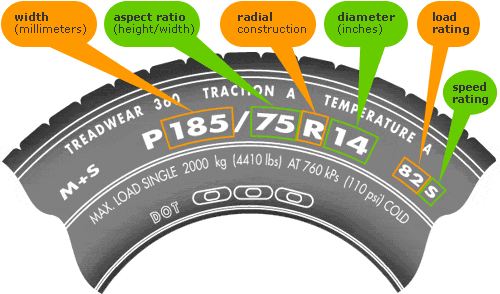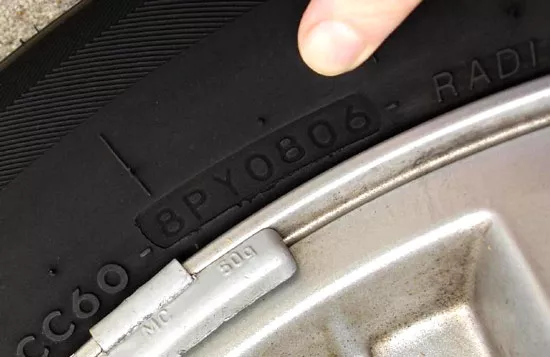There actually are a range of tire specifications for you to take into consideration. Technical specifications of all tires are clearly printed on their sidewalls by the manufacturers, which may include tire brand, size, speed rating, load index, and expiration date (measured in weeks). Do not let these encrypted numbers and symbols confuse you. Read on to learn the way to crack the tire code with Philkotse’s handy guide to deciphering tire types, sizes, and construction.
How To Read Tire Sizes and Specifications?
>>> Read more: How to prolong the lifespan of the tire?

Illustration of tire specifications
The above figure shows a seemingly obscure series: “P185 / 75R14 82S.” Believe it or not, it actually speaks volume about this particular tire. Here is the meaning of each character:
P - Vehicle Type
This first letter tells us this tire can be used on what type of vehicle. P stands for "Passenger", which means it can be used for vehicles that carry "passengers." Some other characters you may encounter include LT or "Light Truck", which is meant for medium to heavy duty trucks with 0.5 - 1 ton load capacity; or T for “Temporary” replacement tires.
185 - Tire Width
The number that comes after the first letter indicates the width of the tire measured in millimeters. This is essentially a measurement of the contact surface of the tire with the road.
75 - Aspect Ratio
The two digit-number after the slash mark is calculated as the height of the tire’s cross-section or sidewall divided by the tire width. In the example above, the tire height is equal to 75% of the tire width (185mm).
R - Tire Construction
The most common tires now have a Radial construction, corresponding to the letter “R” in our example, which simply means that the layers run radially across the tire. Other tire constructions such as B, D, or E can still be found but have become increasingly rarer in the market.
14 - Wheel Diameter
This is the diameter in inches of the wheel measured from one end to the other. In this example, the tire is intended for wheels of 14’’ diameter.
82S - Load Index and Speed Rating
If the load and speed of the vehicle exceeds this recommended figure, a tire explosion is probable.
*82 - Load Index
This is the maximum load that the tire can tolerate. Typically, this number can be anywhere between 75 and 105, equivalent to a load capacity of 380 to 925 kg.
| Load index | Corresponding maximum load |
| 75 | 853 lbs |
| 85 | 1,135 lbs |
| 88 | 1,235 lbs |
| 91 | 1,356 lbs |
| 93 | 1,433 lbs |
| 105 | 2,039 lbs |
*S - Speed Rating
The letter ‘S’ is equivalent to a maximum speed of 180 km/h that the tire can withstand.
| Speed rating | Corresponding maximum speed |
| Q | 99 mph |
| S | 112 mph |
| T | 118 mph |
| U | 124 mph |
| H | 130 mph |
| V | 149 mph |
| Z | >149 mph |
Tire expiration date
Tire specifications also include a series of codes marked in the tire sidewalls that indicate the production period of the tire. For example, if the last 4 digits are 1404, it means that this tire left its production line by the 14th week of 2004. The often recommended tire expiration date is no more than 6 years from the date of manufacture. Once a tire is past its expiry date, it means that it has waned off its original features and you should replace the tires even if they still look new in order to ensure your safety while driving.

This tire was manufactured in the 8th week of 2006
>>> Click here for more helpful tips on car maintenance.










